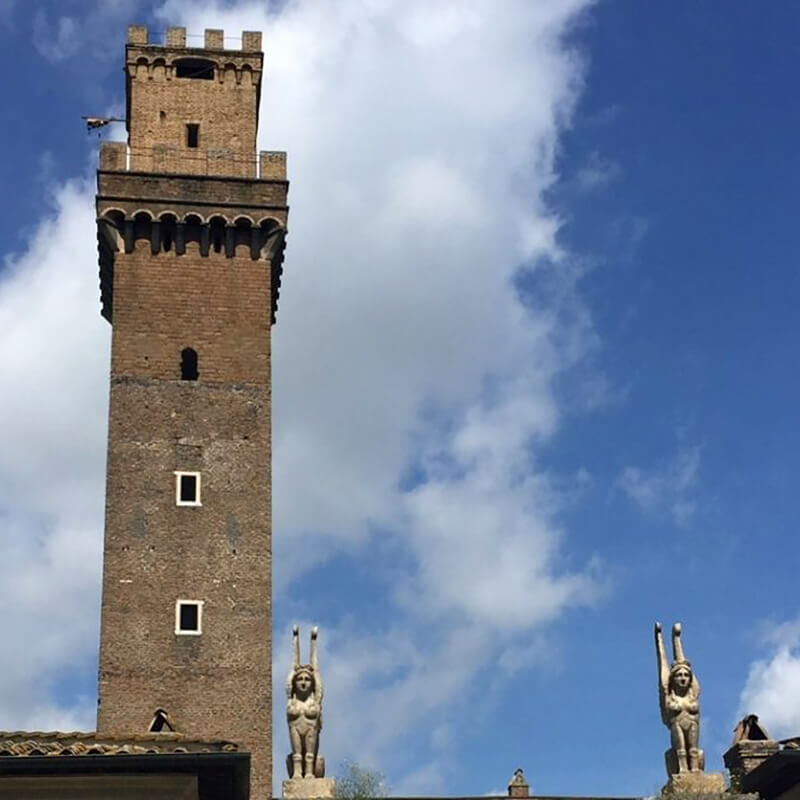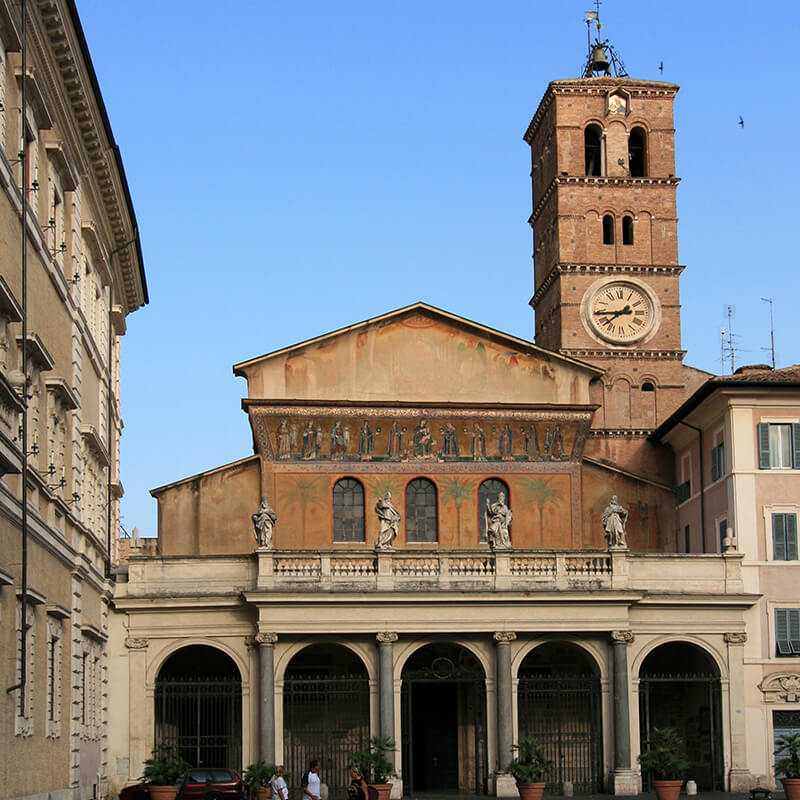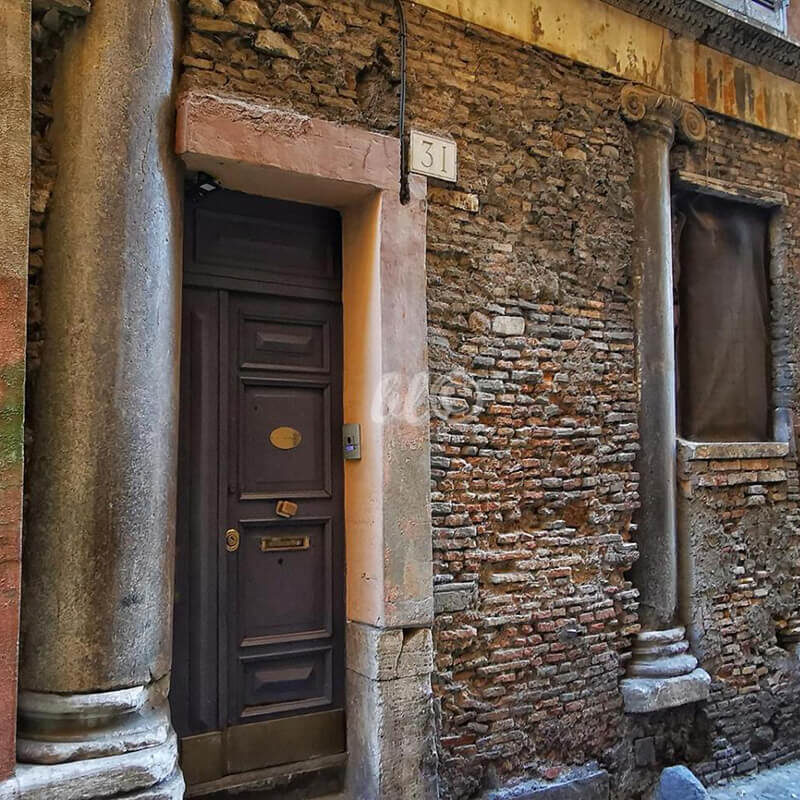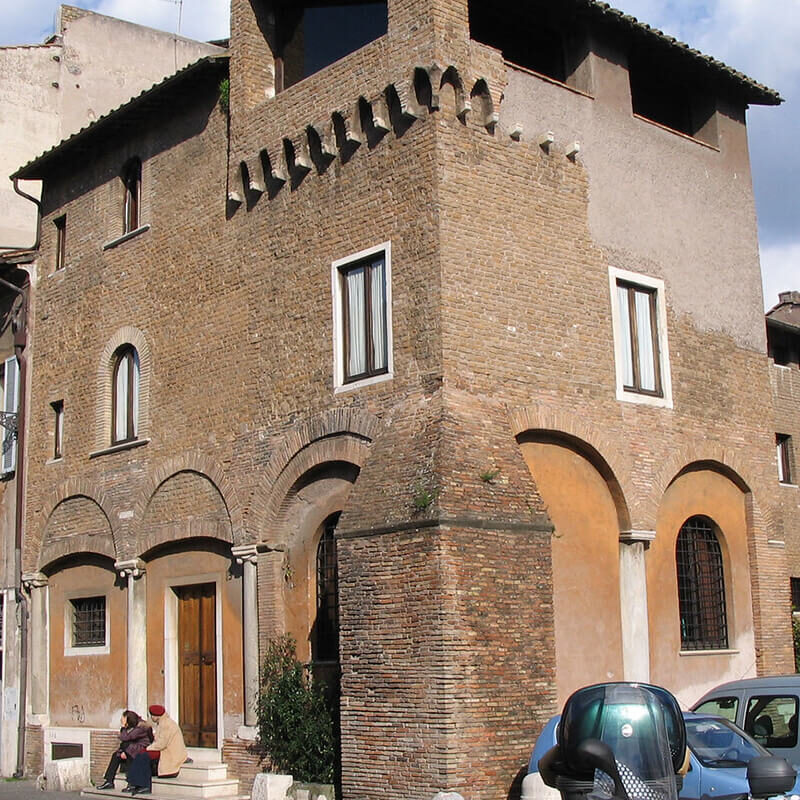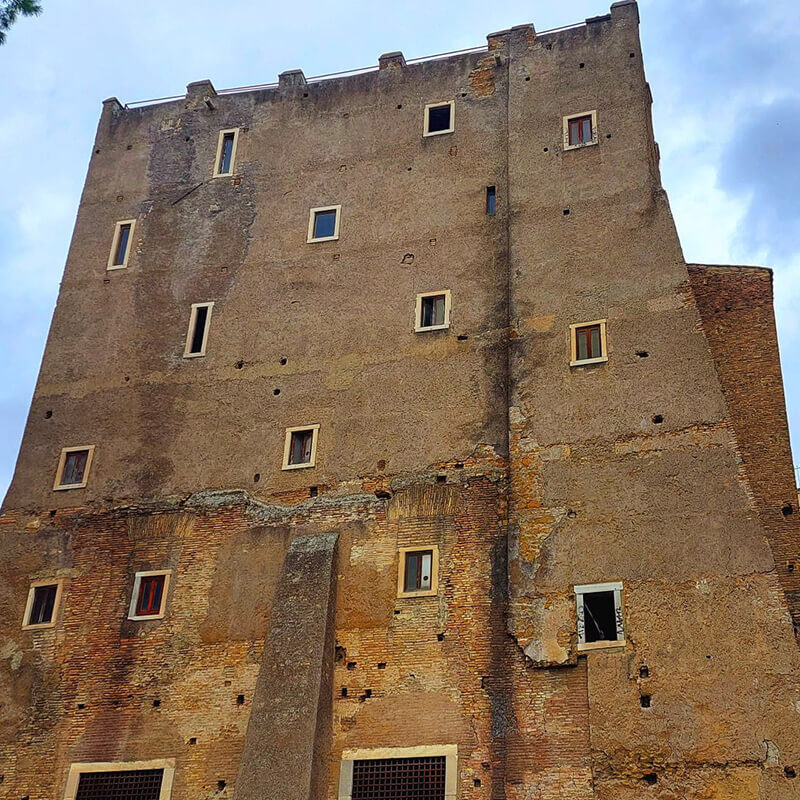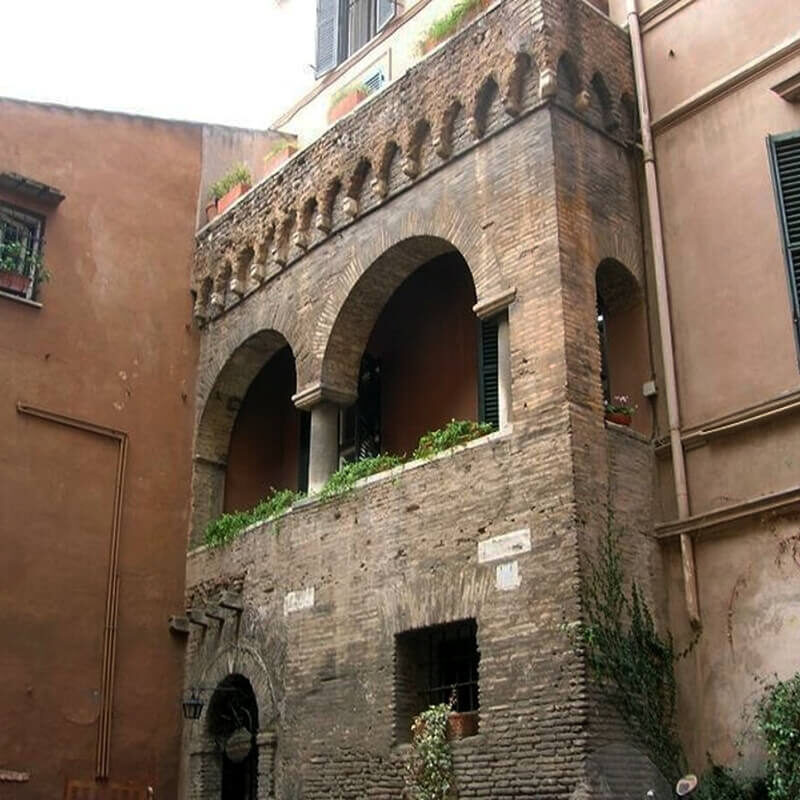As I anticipated, when you visit Rome it is possible to find many characteristic parts of this city, as in the case of the Trastevere district, one of the few places that still retains part of the typical medieval urban layout >. Walking through these narrow alleys it is possible to discover the history of a city torn apart by an internal conflict between the pope and the noble families and at the same time animated by the presence of monastic orders and artisanal activities which have still left traces today in the modern city.
Our tour will start from Piazza Trilussa, one of the main accesses to the Trastevere district. From this square we will stroll admiring the artistic remains of the Middle Ages in Rome, which are often incorporated into buildings constructed during later periods or hidden in places rarely visited by casual tourists. In short, a whole other city than the ancient and baroque one, known by the vast majority of visitors; a city, the medieval one made up of its monuments and works of art which can, in part, be discovered through this route.
Traveling along the entire Via del Moro it is possible to arrive at Piazza di Santa Maria in Trastevere where we will find the church of the same name, the Basilica of Santa Maria in Trastevere, one of the medieval gems of Rome, the first dedicated church in the city to the cult of the Virgin. Inside e Basilica of Santa Maria in Trastevere it is possible to admire the famous mosaics with the Coronation of the Virgin, carried out in the 12th century, and the Stories of the Virgin created by Pietro Cavallini in the 13th century, while not far from the in the apse it is possible to find one of the oldest images of the Virgin that has survived to this day, the Madonna della Misericordia from the 6th century.
The history of the Basilica of Santa Maria in Trastevere is very interesting because it is thought to have been built between the 3rd and 4th centuries AD, probably on the merits of Taberna, where, in 38 BC, a miraculous eruption of oil occurred, interpreted in followed as an annunciation of the birth of Jesus (in reality, more than a miracle, the eruption was caused by the natural emission of oil from the ground).
Leaving the Basilica of Santa Maria in Trastevere and proceeding on Via della Lungaretta we will arrive in front of the Church of San Crisogono, one of the great medieval basilicas of Trastevere. Also inside this church there is an apse with a spectacular 13th century mosaic. Added to this is a high bell tower, 5 floors high, which was built in the 12th century; the most characteristic thing about this church are its basements which allow us to understand the two-thousand-year stratification of the eternal city.
Crossing Viale Trastevere which today separates this district into two parts we arrive at Piazza Sonnino, which is characterized by one of the best-known medieval buildings: the Torre degli Anguillara, better known as the “Dante’s House“. This fortress dating back to the 13th is characterized by a crenellated wall which, fortified by a tower, enclosed houses and stables. The building will be heavily restored in the 19th century due to the works promoted by the Savoys, when Rome became the capital of the kingdom.
Leaving Piazza Sonnino, Torre Anguillara and other ancient monuments such as Excurbitum behind us, we will find ourselves through a series of alleys and paths on Via dei Genovesi, a street that allows us to understand how this district hosted many communities coming from every part of Italy (and not only). Here it was possible to find various artisans and traders whose professions are easily recalled by simply reading the names of the streets in this part of Rome.
From this road it is possible to get to Via di Santa Cecilia, which will lead us to the square dominated by the church of the same name. In front of the entrance to the Basilica of Santa Cecilia, even though it has been extensively remodeled over the centuries, the church has a beautiful Gothic tabernacle inside by Arnolfo di Cambio in the 13th century and precious mosaics in the apse from the 9th century, while the monks’ choir preserves the famous fresco with the Last Judgment created by Pietro Cavallini, the greatest Roman painter of the late 13th century.
Leaving the basilica it is possible to see on the corner of Piazza dei Mercanti a delightful example of a 14th century house, while proceeding again towards Via dei Genovesi it is possible to access a small path , famous not only for its size but above all because in the 19th century the famous statue of the Apoxyomenos was found, a Roman copy from Lysippos depicting an athlete who cleanses himself by scraping off the sweat and the powder mixed with the oil with which he was coated before the fight, and which today can be admired in the Vatican Museums.
Furthermore, at number 14 of the same street, our attention will be attracted by another medieval house dating back to the 13th-14th century, the loggia with pointed arches on stone corbels at the top and has a small column with the inscription in Hebrew which allowed to identify it as the only ancient Jewish synagogue surviving in the neighborhood, which was populated by a sizeable colony of Roman Jews in the Middle Ages before this moved to the current area of the Jewish Ghetto.
When we talk about Trastevere we cannot help but talk about folklore and traditions, in fact in this area of Rome it is certainly the center of the most ancient folklore, people danced the “saltarello“, a typical dance of the regions Abruzzo and Ciociaria from the 14th century and every year since 1535 the traditional “Festa de Noantri” has taken place. The “Festa de Noantri” is a festival dedicated to the Madonna di Carmine but above all to the citizens of Trastevere (Noantri) in contrast with those of the other neighbourhoods (voantri). The religious holiday is celebrated every 16th July and is supported by civil celebrations which include concerts, sports competitions and various attractions, ending with a fireworks display.
Proceeding towards the Tiber in the direction of the Tiberina Island we will pass under the Arco dei Tolomei, a monument that was erected for the noble Sienese family who lived in this neighbourhood from the 14th century, from this point it is easy to reach the Church of San Benedetto in Piscinula with the Casa Mattei, an elegant complex of 14th-century residences. On the ground floor of the building several rooms were occupied subsequently from the “della Sciacquetta” inn.
Among the curiosities linked to the Church of San Benedetto in Piscinula there is certainly the church with the smallest bell tower in Rome; from here the Tiberina Island and what remains of the Caetani Castle are clearly visible, built against the Pierleoni Tower dating back to the 10th century, an important tower because it hosted personalities illustrious like Matilda of Canossa and Pope Victor III in 1087, who hid in the tower to escape the dangers of the army of the antipope Clement II; in 1089, Pope Urban II stayed there and finally the Caetani family became owners of the fortress around the end of the 13th century. The tower, which still dominates the head of the Ponte Fabricio today, is also known as the Torre della Pulzella, referring to the small marble head of a young woman set in the brick facade.
Another characteristic element of the Tiberina Island is certainly the Church of San Bartolomeo all’Isola which despite having a modern façade (even if it retains the 12th century bell tower) inside before the steps of the presbytery, is It is possible to find one of the most important medieval pieces of the church, a marble puteale or a well created from a fragment of a Roman column. It is one of very few pieces of Ottonian art found in Rome, in fact it dates back to the 10th century, to the times of Emperor Otto III, who probably commissioned it.
At the end of this first part of the journey you will notice that of the numerous churches built in the Middle Ages in Rome, only a part remain in their original appearance (about 40) and of the 300 existing medieval towers, today we can only count 50, many of which are absolutely unknown because they are hidden by the buildings against which they stand. In the Middle Ages Rome was not the metropolis we know today, it was much smaller than today and extended along the Tiber, a fundamental resource for water supply and a fundamental communication route especially for trade.
In fact, in the Middle Ages a large part of the population was concentrated in the Trastevere district; along the right bank of the river and here in fact there are still churches and residential buildings dating back to the Middle Ages but also the towers which were residences and fortresses of aristocratic families and symbols of their power. Over the following centuries, the face of Rome will change above all due to the succession of different fashions, and precisely for this reason that many of these tower-houses were demolished or incorporated starting from the Renaissance, where the residential palace style took hold and the towers were incorporated into the new buildings or otherwise totally demolished.
From the Tiberina Island it is possible to get to the Jewish Ghetto and then to the Campidoglio and from here you can continue the tour of Medieval Rome proceeding towards via Rione Monti where along Via dei Fori Imperiali you can come across the famous Church of Saints Cosma and Damiano, a place of worship made up of ancient buildings of the library of the Forum of Peace and the hall of the Temple of the Divine Romulus.
Proceeding towards San Giovanni and Santa Maria Maggiore passing by the Basilica of San Clemente, with its characteristic stratified structure, or that of the Santi Quattro Coronati with the Oratory of San Silvestro and its cloister, and finally that of Santo Stefano Rotondo which has its entrance under one of the arches of the Aqueduct of Nero. The church has a circular plant, one of the masterpieces of early Christian architecture dating back to around the 5th century AD, built on a Roman barracks and near a mitreum and a domus of the Valeri.
Or if you decide to move towards Campo dei Fiori and Piazza Navona, you will also be able to notice in these parts how another splendid crystallization of a vanished Rome is hidden as in the case of the so-called Arco degli Acetari .
What are you waiting for to discover medieval Rome on a 3-hour or 6-hour tour, perhaps combining it with a thematic experience? Contact me for info and reservations.

